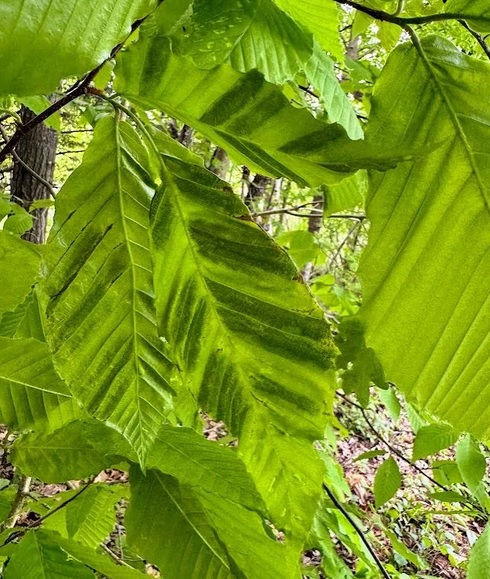A few weeks ago a reader suggested I write about beech leaf disease, but I said it wasn’t that big a deal. Then I went for a walk in the woods and was astonished – but not in a good way.
“Our beech has been dealing with bark disease for so long they’re already in trouble. This is the straw that broke the back,” said Kyle Lombard, a forest health specialist with the state Division of Forest and Lands. “Trees are just not surviving.”
The disease is so widespread that the state doesn’t ask people to report it any more. There’s no biocontrol in the works, so unless you spend a fortune on spraying to save a tree in your yard, they’re gone. The species is doomed here.
Beech leaf disease is the latest in the litany of debilitating forest diseases to be accidentally imported or that have expanded north as our weaker winters stop protecting us from all the nasty stuff in warm climates. We wiped out all the elms and chestnuts, and now hemlock is under assault by bugs. A fungal disease called rust is killing pines, sugar maples are climate-stressed and invasives, like bittersweet, autumn olive and Japanese knotweed, are spreading like crazy.
It’s enough to make me despair. Don’t, says Lombard.
“The forests that are here now were not here 500 years ago, and forests 500 years from now will not be the same as those here now. We have to accept that the forest is in a constant state of change, and as long as we don’t turn it into a Walmart parking lot, we’ll be fine. Flora and fauna will adapt and change,” he said.
That doesn’t mean it won’t be messy, of course.
“Humans like what we have, so it’s hard for us to accept change,” he said after I slipped into woe-is-us mode during our interview. Something will replace beech, he said, and even if we don’t like it, the forest will be there.
“When there was chestnut in the Northeast there was no oak – oak sort of replaced chestnut… Our grandkids and great-grandkids will love whatever comes in. It’s just hard to live with it when it happens so fast.”
Still, he admits that losing beech within a decade will be a big blow.
“It’s a keystone species, one of the major components of the northern hardwood forest… which covers half of New Hampshire,” Lombard said.
Beech trees are the ones with smooth light-gray bark and branches that stick straight out in all directions. If you help maintain hiking trails in the woods, you’ve spent a lot of time trimming back those branches, which are notorious face-slappers.
Loggers don’t like beech – the wood isn’t worth much and they spring up quickly, shading out more valuable species – but wildlife does. Beech nuts are a big part of the diet for everything from bears to chipmunks.
For decades, the species has been struggling with beech bark disease, caused when scale insects burrow into trees carrying a fungus. Those trunks get mottled and covered with black sores. Millions of trees in the Northeast have died from the disease, but it hasn’t wiped out the species the way chestnut and elm trees were eliminated by new diseases.
But now comes beech leaf disease, which showed up in Ohio in 2012, possibly introduced from Japan and is spreading fast.
It is caused by a microscopic worm-like nematode and associated fungi or bacteria. It creates dark bands between veins of the leaves and eventually makes leaves curl up and fall off.
That’s what shocked me in the woods: Lots of mature, otherwise healthy beech trees with half their leaves missing and the other half curled and dead-looking. It was as if they had been poisoned.
“When this thing first hit the Midwest there wasn’t a lot of mortality for the first 5 or 10 years. People were cautiously optimistic that it wasn’t going to be too bad,” said Lombard. “But beech bark disease hasn’t gotten to the Midwest.”
It arrived in New Hampshire a few years ago and has been spreading north. Everywhere up to the Lakes Region has now been infected, and the double whammy of bark and leaf disease is taking its toll.
“It’s a lot worse in the area that have had it previously. At three years, we’re starting to see real damage,” Lombard said.
I don’t know what a mature American chestnut looks like and my granddaughter won’t know what a mature beech tree looks like.
Such is the circle of life, I guess.


 Return to the Concord Monitor
Return to the Concord Monitor
There was oak in the northeast even when chestnut was a dominant species. What we didn’t have then that is prevalent now are invasive plants and a warmer climate. I doubt your grandkids will love buckthorn, bittersweet, and all the other invasives that will dominate their future forests. While the beech forest is currently not looking well, there is (or was) research being done to find a treatment for beech leaf disease, so it’s too early to tell how this will play out. Hopefully scientists with more optimism will continue to have the opportunity to study this and whatever comes next. Forests, and everything else on this planet, are not guaranteed. If only the notion that we just have to accept change meant we would change our behaviors in order to preserve the things we like…
I miss the enormous elms on Main Street and elsewhere in and around Concord, in the 1970s.
Now I live outside of NH, and that’s why I can’t see other species such as Shagbark Hickories, Sassafras, and others; I wonder how they are doing in current climate conditions.